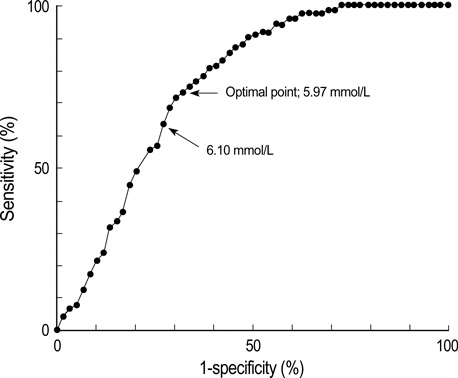J Korean Med Sci.
2005 Aug;20(4):562-565. 10.3346/jkms.2005.20.4.562.
Fasting Plasma Glucose Cutoff Value for the Prediction of Future Diabetes Development: A Study of Middle-Aged Koreans in a Health Promotion Center
- Affiliations
-
- 1Department of Internal Medicine, Ilsan-Paik Hospital, Inje University College of Medicine, Goyang, Korea.
- 2Department of Preventive Medicine, Ajou University School of Medicine, Suwon, Korea.
- 3Division of Endocrinology and Metabolism, Department of Medicine, Samsung Medical Center, Sungkyunkwan University School of Medicine, Korea. kwwkim@smc.samsung.co.kr
- 4Center for Health Promotion, Samsung Medical Center, Sungkyunkwan University School of Medicine, Seoul, Korea.
- KMID: 1712733
- DOI: http://doi.org/10.3346/jkms.2005.20.4.562
Abstract
- We determined optimal fasting plasma glucose (FPG) cutoff values predictive of future diabetes development in a group of middle-aged Koreans who visited a health promotion center. The medical records of 2,964 subjects, who attended the Health Promotion Center in 1998 and 2003, were examined. Subjects were classified into four groups according to their baseline FPG values (Group 1:FPG <5.0 mM/L; Group 2: 5.0
Keyword
MeSH Terms
-
Adult
Aged
Blood Glucose/*metabolism
Blood Pressure
Body Mass Index
Community Health Centers/statistics & numerical data
Diabetes Mellitus/*blood/epidemiology/etiology
Fasting/*blood
Female
Follow-Up Studies
*Health Promotion
Humans
Incidence
Korea/epidemiology
Lipoproteins, HDL Cholesterol/blood
Lipoproteins, LDL Cholesterol/blood
Male
Middle Aged
Predictive Value of Tests
Risk Factors
Triglycerides/blood
Figure
Reference
-
1. Coutinho M, Gerstein HC, Wang Y, Yusuf S. The relationship between glucose and incident cardiovascular events. A metaregression analysis of published data from 20 studies of 95,783 individuals followed for 124 years. Diabetes Care. 1999. 22:233–240.
Article2. The DECODE Study Group, on behalf of the Europian Diabetes Epidemiology Group. Is the current definition for diabetes relevant to mortality risk from all causes and cardiovascular and noncardiovascular disease? Diabetes Care. 2003. 26:688–696.3. Shaw JE, Zimmet PZ, Hodge AM, de Courten M, Dowse GK, Chitson P, Tuomilehto J, Alberti KG. Impaired fasting glucose: how low should it go? Diabetes Care. 2000. 23:34–39.
Article4. Shaw J, Zimmet P, de Courten M, Dowse GK, Chitson P, Gareeboo H, Hemraj F, Fareed D, Tuomilehto J, Alberti KG. Impaired fasting glucose or impaired glucose tolerance. What best predicts future diabetes in Mauritius? Diabetes Care. 1999. 22:399–402.
Article5. Gabir MM, Hanson RL, Dabelea D, Imperatore G, Roumain J, Bennett PH, Knowler WC. The 1997 American Diabetes Association and 1999 World Health Organization criteria for hyperglycemia in the diagnosis and prediction of diabetes. Diabetes Care. 2000. 23:1108–1112.
Article6. Kim DJ, Kim KW, Cho NH, Noh JH, Lee MS, Lee MK. The cutoff value of fasting plasma glucose to differentiate frequencies of cardiovascular risk factors in a Korean population. Diabetes Care. 2003. 26:3354–3356.
Article7. Kim DJ, Cho NH, Noh JH, Lee MS, Lee MK, Kim KW. Lack of excess maternal transmission of type 2 diabetes in a Korean population. Diabetes Res Clin Pract. 2004. 65:117–124.
Article8. Expert Committee on the Diagnosis and Classification of diabetes mellitus. Follow-up report on the diagnosis of diabetes mellitus. Diabetes Care. 2003. 26:3160–3167.9. Park JY, Kim YI, Choi CS, Chung YE, Kim SW, Lee MS, Lee SI, Hong SK, Lee KU. Prevalence of diabetes, impaired glucose tolerance, and impaired fasting glucose in a rural population of Korea, according to 1997 American Diabetes Association and 1985 World Health Organization criteria. Diabetes Care. 2000. 23:707–708.
Article10. Choi KM, Lee J, Kim DR, Kim SK, Shin DH, Kim NH, Park IB, Choi DS, Baik SH. Comparison of ADA and WHO criteria for the diagnosis of diabetes in elderly Koreans. Diabet Med. 2002. 19:853–857.
Article
- Full Text Links
- Actions
-
Cited
- CITED
-
- Close
- Share
- Similar articles
-
- Measurement and Treatment Goal of Postprandial Hyperglycemia
- What will be the Proper Criteria for Impaired Fasting Glucose for Korean Men?: Based on Medical Screening Data from a General Hospital
- A Comparison of Fasting Glucose and HbA1c for the Diagnosis of Diabetes Mellitus Among Korean Adults
- A Potential Issue with Screening Prediabetes or Diabetes Using Serum Glucose: A Delay in Diagnosis
- The Combination of Fasting Plasma Glucose and Glycosylated Hemoglobin as a Predictor for Type 2 Diabetes in Korean Adults (Korean Diabetes J 33(4):306-314, 2009)


